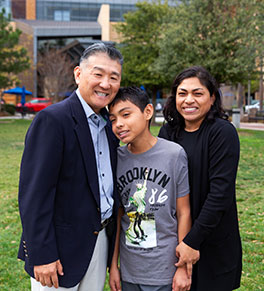Removing blinding cataracts brightens autistic teen’s outlook

When 13-year-old Thiago Rojas began rubbing and tapping his eyes, Sherry Sandoval thought her son might simply be exhibiting new “stimming” behavior — repetitive self-stimulating movements that people with autism and developmental disorders often use to self-regulate.
Thiago’s doctor examined the teenager then referred him to pediatric ophthalmologist Dr. Donny Suh at the UCI Health Gavin Herbert Eye Institute for further evaluation. Suh has extensive experience providing vision care to young patients like Thiago, who had been diagnosed with autism, developmental delays and severe attention deficit/hyperactivity disorder (ADHD).
At their first meeting in fall 2024, the teenager was angry and unpredictable.
“Some kids don’t like to be touched on their face or lights shining in their eyes,” explains Suh, who serves as the eye institute’s chief of pediatric ophthalmology. “Or they may be afraid of fast movements. Every child is different, so our entire team has to be adaptable. We offer different tools and equipment for pediatric patients who may not be able to cooperate with a traditional eye exam.”
Sandoval immediately sensed the physician’s empathy for Thiago. Suh quickly identified the source of the boy’s frustration: Severe cataracts in both eyes forced him to navigate the world through a thick, blurry fog, unable to convey his problem to those who loved him most. It was understandable that he felt angry and was acting out, the children’s eye specialist says.
Thiago’s case was extremely rare, with cataracts seen in fewer than .01% of children. Surgery to remove a child’s clouded lens — so common for older adults — usually requires general anesthesia and specialized techniques to account for their softer and smaller eyes.
Suh operated twice on Thiago in 2024, removing the cataracts one eye at a time. Within days of each surgery, the teenager’s vision improved dramatically. It also completely changed his day-to-day experiences at school, at play and at home with his two siblings. Now he joyfully engages in all his favorite activities, including solving jigsaw puzzles and watching music videos.
The habit that first caught Thiago’s mother’s attention — tapping his eyes — has disappeared.
All too often children experiencing vision problems wipe and rub their eyes to try and see more clearly, Suh says. It’s a signal that an eye exam may be needed.
“It’s especially important for kids with developmental delays to receive careful and comprehensive eye examinations,” he says. “If these children have vision impairment, it can further hinder their emotional, physical and social development at a very critical time in their lives.”
As the boy’s beaming smile for Suh at a recent checkup shows, Thiago is seeing his own future shine more brightly now.
Related stories
- His passion: Helping kids see
- Plant-based meals for finicky kids
- Envisioning the future of eye care ›




